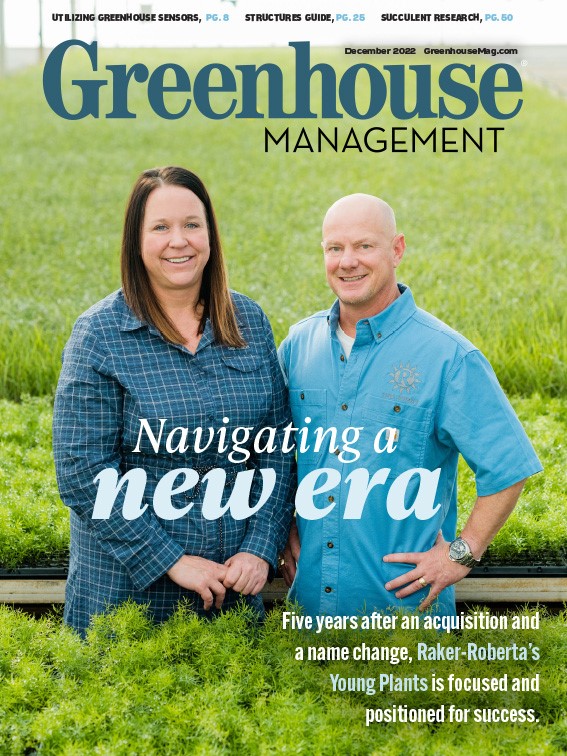
For Dan VanWingerden, owner of Green Legacy in Orient, Ohio, refurbishing a greenhouse wasn’t his first choice. But it was the right one.
“I think the biggest pull for us was the amount of money it takes to rebuild a used facility compared to building new,” he says.
He adds that he was able to get an AgCredit loan through the USDA that he qualified for because of his age. VanWingerden is 26 years old and co-owns the business with his wife. Green Legacy primarily produces annuals and mums.
“This was the first farm we purchased,” he says. “USDA was actually able to guarantee 95% of the loan, which meant we had to put very, very little money down. That’s what made it possible. Otherwise, there was not a possibility we could have done this.”
The right facility
The Green Legacy facility is about 5 acres and sits on 35 acres of land in Orient, roughly a 20-minute drive from Columbus. VanWingerden purchased the greenhouse in December 2021 from the Cuthbert family, who own Cuthbert’s Greenhouse in nearby Groveport, Ohio.
The facility, VanWingerden says, “was laid out in a way that allowed them to truly retrofit it” to be more efficient.
“You could see the low hanging fruit,” he says, “and we’re only halfway there with the retrofitting process. Once we finish tearing down some more walls and really opening it up, it can be a state-of-the-art facility. It just needs attention.”
Retrofitting the facility has so far meant reorganizing the facility so everything moves in a circular fashion. They also removed several tables (the Cuthberts kept them as part of the deal) in order to grow on the greenhouse floor, which VanWingerden says is more efficient for his production plan and expands growing capacity by roughly 35%.
When he visited the facility, he says several factors made the decision a “no brainer.”
“No. 1, again, it was economically feasible,” VanWingerden says. “No. 2 is that I visited it with a few of my mentors — my own father and my uncle John from Green Circle. The three of us walked through and I just picked their brain and said, ‘hey guys, what do you see here?’ And with all of their experience, they were able to say, ‘this thing has good bones.’ And No. 3, the original owner was still on the property and he offered his assistance through the transition. He could help me when a boiler went down and he was there to sort of train me along.”

First steps
VanWingerden says he came under contract to buy the facility in July 2020 with closing set for January 2021.
“We, right away, had five months to start planning without having to run the greenhouse,” he says. “That allowed us the time to sit back and decide what we were going to do with this place. Having that time, without the costs associated, was huge.”
A few decisions were made in that time that VanWingerden deems “pivotal.” For one, they decided to begin growing while the retrofitting process began.
“We needed the cash flow to support the updates that we were going to make,” he says. “Right away, we filled up the greenhouse growing for other larger growers. We contract grew the first year. That was just to get money in the door, get to know the facility, all of that.”
He notes that, at that time, “everyone” was looking for space, so it wasn’t hard to find customers.
From there, they made several visits to the facility in that five-month span to consult with the Cuthberts, but also suppliers such as Agronomix (in order to layout a 16-acre master plan they’ll eventually build out) and Profile Products (the facility uses HydraFiber and has a processing unit on site). Additionally, VanWingerden and his family began the process of moving from Kentucky (he previously was the general manager at ColorPoint in Paris, Kentucky).
“I came to an agreement with the old owner to take the old tables and convert that to floor production,” he says. “We started the process before we owned the facility by agreeing that we would give them all of the components. They did all of the labor before we owned it by ripping out all of those benches and getting that ready.”
He also hired four people from Kentucky to come with him to Orient and that five-man team got to work. Plant production began in February and the next phase of the retrofit began in the spring.
“Because I had the support of so many, I was not making these decisions on my own,” VanWingerden says. “My wife and I are the owners, but I welcomed everyone’s input. I think I became sort of a project for them to come down here and have them say ‘oh, you should do this’ or ‘you should do that.’ There was just a lot of really solid, good advice. And what gave me the confidence, and what made it easier than I was expecting, was having all of that support.”
Next steps
VanWingerden says that, if he had all of the money he needed to spend, retrofitting wouldn’t be his first choice.
“I would buy land and build new,” he says. “There’s no question. Retrofitting a greenhouse is hard. However, to buy with minimal money down and reinvest based on cash flow and also take on more debt to actually make a feasible, strong company, that would not have been possible with the money we initially started out with. That was the motivating factor to what the last two years have been.”
Now there are plans to keep building this facility and molding it into what VanWingerden wants. In addition to expanding to 15 acres over time, he says they’ll add a pond or a well to the property to increase water supply. (The facility does not have access to city water.) They’ll also add a water treatment tank to avoid any disease issues.
Green Legacy also has an evolving customer base. VanWingerden says they’ve moved beyond contract growing for independent garden centers and landscapers. In 2022, landscapers accounted for 25% of sales; the goal for 2023 is closer to 40%.
“It wasn’t easy,” he continues. “I’m not going to sugarcoat it and say that these past two years haven’t been tough. Especially with all of the economic walls you hit. But we’ve been able to go through two successful years with the whole retrofitting process. ... The motivation for retrofitting is purely economical. What we’ve been able to accomplish here is from being able to buy a much cheaper facility than it would have cost to build new.”

Explore the December 2022 Issue
Check out more from this issue and find you next story to read.
Latest from Greenhouse Management
- Proven Winners introduces more than 100 new varieties for 2025
- UF/IFAS researchers work to make beer hops a Florida crop
- CIOPORA appoints Micaela Filippo as vice secretary-general
- Passion grows progress
- Registration opens for Darwin Perennials Day
- U.S. Department of Labor finalizes farmworker protection rule
- Azo Root is now available from Harrell’s
- Bidens ferulifolia Blazing Glory





